Junlin Li
Frequency-Assisted Adaptive Sharpening Scheme Considering Bitrate and Quality Tradeoff
Aug 12, 2025Abstract:Sharpening is a widely adopted technique to improve video quality, which can effectively emphasize textures and alleviate blurring. However, increasing the sharpening level comes with a higher video bitrate, resulting in degraded Quality of Service (QoS). Furthermore, the video quality does not necessarily improve with increasing sharpening levels, leading to issues such as over-sharpening. Clearly, it is essential to figure out how to boost video quality with a proper sharpening level while also controlling bandwidth costs effectively. This paper thus proposes a novel Frequency-assisted Sharpening level Prediction model (FreqSP). We first label each video with the sharpening level correlating to the optimal bitrate and quality tradeoff as ground truth. Then taking uncompressed source videos as inputs, the proposed FreqSP leverages intricate CNN features and high-frequency components to estimate the optimal sharpening level. Extensive experiments demonstrate the effectiveness of our method.
Adaptive High-Frequency Preprocessing for Video Coding
Aug 12, 2025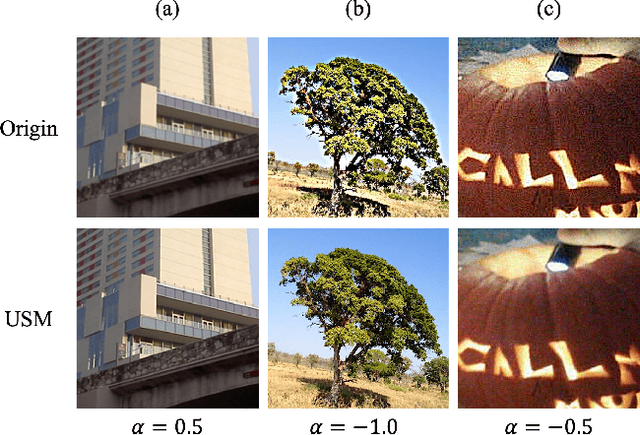

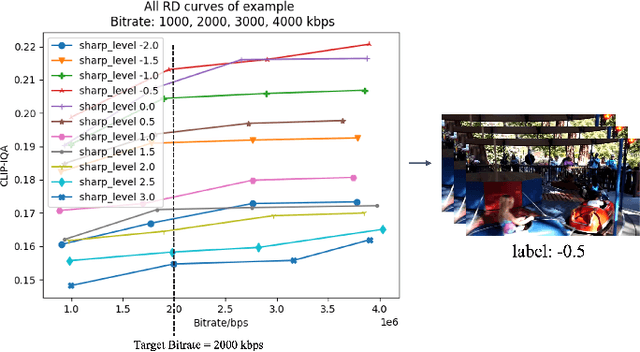
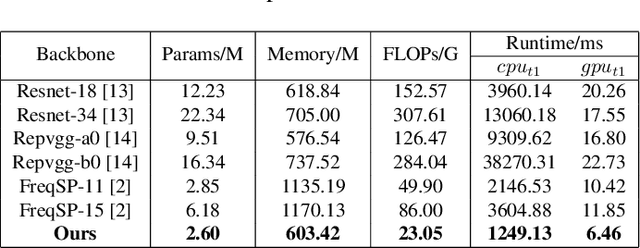
Abstract:High-frequency components are crucial for maintaining video clarity and realism, but they also significantly impact coding bitrate, resulting in increased bandwidth and storage costs. This paper presents an end-to-end learning-based framework for adaptive high-frequency preprocessing to enhance subjective quality and save bitrate in video coding. The framework employs the Frequency-attentive Feature pyramid Prediction Network (FFPN) to predict the optimal high-frequency preprocessing strategy, guiding subsequent filtering operators to achieve the optimal tradeoff between bitrate and quality after compression. For training FFPN, we pseudo-label each training video with the optimal strategy, determined by comparing the rate-distortion (RD) performance across different preprocessing types and strengths. Distortion is measured using the latest quality assessment metric. Comprehensive evaluations on multiple datasets demonstrate the visually appealing enhancement capabilities and bitrate savings achieved by our framework.
Region-Adaptive Video Sharpening via Rate-Perception Optimization
Aug 12, 2025Abstract:Sharpening is a widely adopted video enhancement technique. However, uniform sharpening intensity ignores texture variations, degrading video quality. Sharpening also increases bitrate, and there's a lack of techniques to optimally allocate these additional bits across diverse regions. Thus, this paper proposes RPO-AdaSharp, an end-to-end region-adaptive video sharpening model for both perceptual enhancement and bitrate savings. We use the coding tree unit (CTU) partition mask as prior information to guide and constrain the allocation of increased bits. Experiments on benchmarks demonstrate the effectiveness of the proposed model qualitatively and quantitatively.
POQD: Performance-Oriented Query Decomposer for Multi-vector retrieval
May 25, 2025Abstract:Although Multi-Vector Retrieval (MVR) has achieved the state of the art on many information retrieval (IR) tasks, its performance highly depends on how to decompose queries into smaller pieces, say phrases or tokens. However, optimizing query decomposition for MVR performance is not end-to-end differentiable. Even worse, jointly solving this problem and training the downstream retrieval-based systems, say RAG systems could be highly inefficient. To overcome these challenges, we propose Performance-Oriented Query Decomposer (POQD), a novel query decomposition framework for MVR. POQD leverages one LLM for query decomposition and searches the optimal prompt with an LLM-based optimizer. We further propose an end-to-end training algorithm to alternatively optimize the prompt for query decomposition and the downstream models. This algorithm can achieve superior MVR performance at a reasonable training cost as our theoretical analysis suggests. POQD can be integrated seamlessly into arbitrary retrieval-based systems such as Retrieval-Augmented Generation (RAG) systems. Extensive empirical studies on representative RAG-based QA tasks show that POQD outperforms existing query decomposition strategies in both retrieval performance and end-to-end QA accuracy. POQD is available at https://github.com/PKU-SDS-lab/POQD-ICML25.
Knowledge Grafting of Large Language Models
May 24, 2025Abstract:Cross-capability transfer is a key challenge in large language model (LLM) research, with applications in multi-task integration, model compression, and continual learning. Recent works like FuseLLM and FuseChat have demonstrated the potential of transferring multiple model capabilities to lightweight models, enhancing adaptability and efficiency, which motivates our investigation into more efficient cross-capability transfer methods. However, existing approaches primarily focus on small, homogeneous models, limiting their applicability. For large, heterogeneous models, knowledge distillation with full-parameter fine-tuning often overlooks the student model's intrinsic capacity and risks catastrophic forgetting, while PEFT methods struggle to effectively absorb knowledge from source LLMs. To address these issues, we introduce GraftLLM, a novel method that stores source model capabilities in a target model with SkillPack format. This approach preserves general capabilities, reduces parameter conflicts, and supports forget-free continual learning and model fusion. We employ a module-aware adaptive compression strategy to compress parameter updates, ensuring efficient storage while maintaining task-specific knowledge. The resulting SkillPack serves as a compact and transferable knowledge carrier, ideal for heterogeneous model fusion and continual learning. Experiments across various scenarios demonstrate that GraftLLM outperforms existing techniques in knowledge transfer, knowledge fusion, and forget-free learning, providing a scalable and efficient solution for cross-capability transfer. The code is publicly available at: https://github.com/duguodong7/GraftLLM.
Neural Parameter Search for Slimmer Fine-Tuned Models and Better Transfer
May 24, 2025Abstract:Foundation models and their checkpoints have significantly advanced deep learning, boosting performance across various applications. However, fine-tuned models often struggle outside their specific domains and exhibit considerable redundancy. Recent studies suggest that combining a pruned fine-tuned model with the original pre-trained model can mitigate forgetting, reduce interference when merging model parameters across tasks, and improve compression efficiency. In this context, developing an effective pruning strategy for fine-tuned models is crucial. Leveraging the advantages of the task vector mechanism, we preprocess fine-tuned models by calculating the differences between them and the original model. Recognizing that different task vector subspaces contribute variably to model performance, we introduce a novel method called Neural Parameter Search (NPS-Pruning) for slimming down fine-tuned models. This method enhances pruning efficiency by searching through neural parameters of task vectors within low-rank subspaces. Our method has three key applications: enhancing knowledge transfer through pairwise model interpolation, facilitating effective knowledge fusion via model merging, and enabling the deployment of compressed models that retain near-original performance while significantly reducing storage costs. Extensive experiments across vision, NLP, and multi-modal benchmarks demonstrate the effectiveness and robustness of our approach, resulting in substantial performance gains. The code is publicly available at: https://github.com/duguodong7/NPS-Pruning.
Multi-Modality Expansion and Retention for LLMs through Parameter Merging and Decoupling
May 21, 2025Abstract:Fine-tuning Large Language Models (LLMs) with multimodal encoders on modality-specific data expands the modalities that LLMs can handle, leading to the formation of Multimodal LLMs (MLLMs). However, this paradigm heavily relies on resource-intensive and inflexible fine-tuning from scratch with new multimodal data. In this paper, we propose MMER (Multi-modality Expansion and Retention), a training-free approach that integrates existing MLLMs for effective multimodal expansion while retaining their original performance. Specifically, MMER reuses MLLMs' multimodal encoders while merging their LLM parameters. By comparing original and merged LLM parameters, MMER generates binary masks to approximately separate LLM parameters for each modality. These decoupled parameters can independently process modality-specific inputs, reducing parameter conflicts and preserving original MLLMs' fidelity. MMER can also mitigate catastrophic forgetting by applying a similar process to MLLMs fine-tuned on new tasks. Extensive experiments show significant improvements over baselines, proving that MMER effectively expands LLMs' multimodal capabilities while retaining 99% of the original performance, and also markedly mitigates catastrophic forgetting.
Q-Insight: Understanding Image Quality via Visual Reinforcement Learning
Mar 28, 2025



Abstract:Image quality assessment (IQA) focuses on the perceptual visual quality of images, playing a crucial role in downstream tasks such as image reconstruction, compression, and generation. The rapid advancement of multi-modal large language models (MLLMs) has significantly broadened the scope of IQA, moving toward comprehensive image quality understanding that incorporates content analysis, degradation perception, and comparison reasoning beyond mere numerical scoring. Previous MLLM-based methods typically either generate numerical scores lacking interpretability or heavily rely on supervised fine-tuning (SFT) using large-scale annotated datasets to provide descriptive assessments, limiting their flexibility and applicability. In this paper, we propose Q-Insight, a reinforcement learning-based model built upon group relative policy optimization (GRPO), which demonstrates strong visual reasoning capability for image quality understanding while requiring only a limited amount of rating scores and degradation labels. By jointly optimizing score regression and degradation perception tasks with carefully designed reward functions, our approach effectively exploits their mutual benefits for enhanced performance. Extensive experiments demonstrate that Q-Insight substantially outperforms existing state-of-the-art methods in both score regression and degradation perception tasks, while exhibiting impressive zero-shot generalization to comparison reasoning tasks. Code will be available at https://github.com/lwq20020127/Q-Insight.
GenDR: Lightning Generative Detail Restorator
Mar 09, 2025Abstract:Recent research applying text-to-image (T2I) diffusion models to real-world super-resolution (SR) has achieved remarkable success. However, fundamental misalignments between T2I and SR targets result in a dilemma between inference speed and detail fidelity. Specifically, T2I tasks prioritize multi-step inversion to synthesize coherent outputs aligned with textual prompts and shrink the latent space to reduce generating complexity. Contrariwise, SR tasks preserve most information from low-resolution input while solely restoring high-frequency details, thus necessitating sufficient latent space and fewer inference steps. To bridge the gap, we present a one-step diffusion model for generative detail restoration, GenDR, distilled from a tailored diffusion model with larger latent space. In detail, we train a new SD2.1-VAE16 (0.9B) via representation alignment to expand latent space without enlarging the model size. Regarding step-distillation, we propose consistent score identity distillation (CiD) that incorporates SR task-specific loss into score distillation to leverage more SR priors and align the training target. Furthermore, we extend CiD with adversarial learning and representation alignment (CiDA) to enhance perceptual quality and accelerate training. We also polish the pipeline to achieve a more efficient inference. Experimental results demonstrate that GenDR achieves state-of-the-art performance in both quantitative metrics and visual fidelity.
FGS-SLAM: Fourier-based Gaussian Splatting for Real-time SLAM with Sparse and Dense Map Fusion
Mar 03, 2025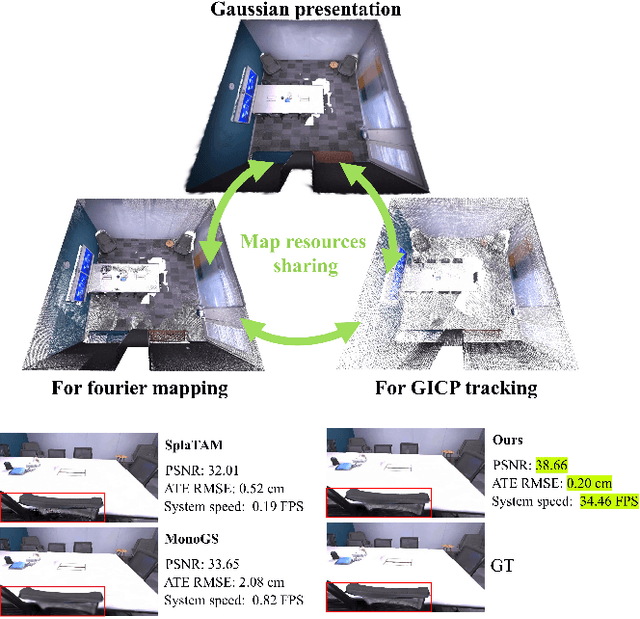
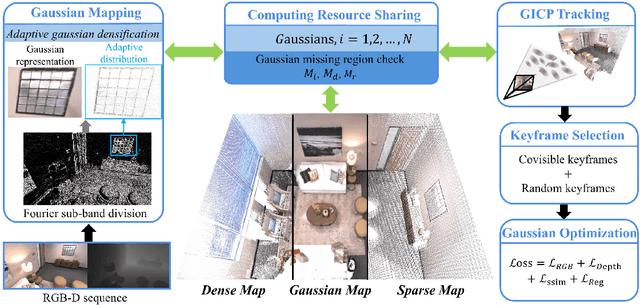
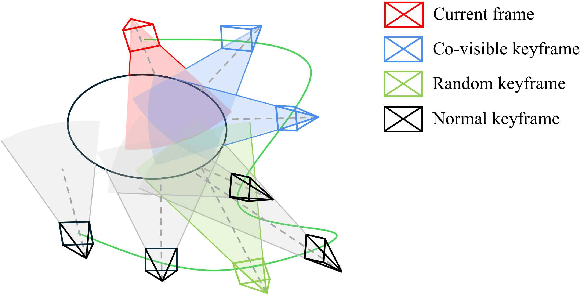
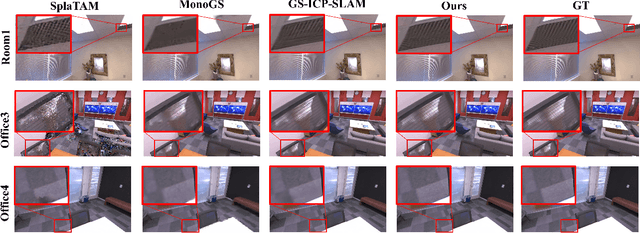
Abstract:3D gaussian splatting has advanced simultaneous localization and mapping (SLAM) technology by enabling real-time positioning and the construction of high-fidelity maps. However, the uncertainty in gaussian position and initialization parameters introduces challenges, often requiring extensive iterative convergence and resulting in redundant or insufficient gaussian representations. To address this, we introduce a novel adaptive densification method based on Fourier frequency domain analysis to establish gaussian priors for rapid convergence. Additionally, we propose constructing independent and unified sparse and dense maps, where a sparse map supports efficient tracking via Generalized Iterative Closest Point (GICP) and a dense map creates high-fidelity visual representations. This is the first SLAM system leveraging frequency domain analysis to achieve high-quality gaussian mapping in real-time. Experimental results demonstrate an average frame rate of 36 FPS on Replica and TUM RGB-D datasets, achieving competitive accuracy in both localization and mapping.
 Add to Chrome
Add to Chrome Add to Firefox
Add to Firefox Add to Edge
Add to Edge